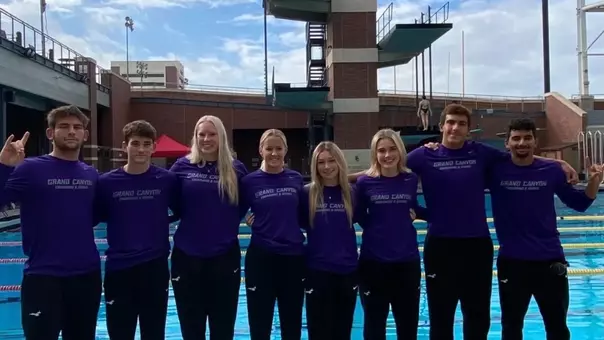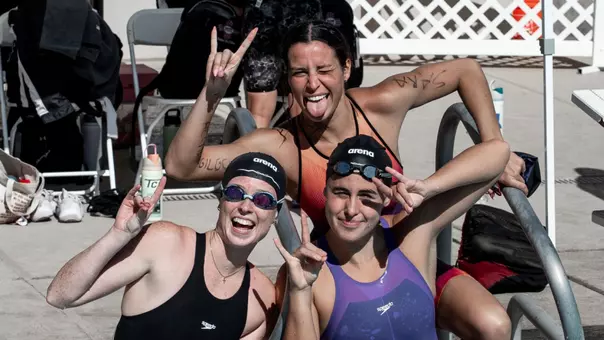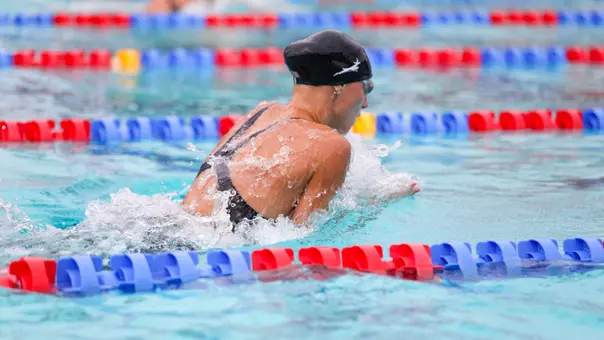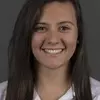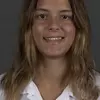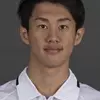Grand Canyon University Athletics

Photo by: Slaven Gujic
Coro: Boasting best of both worlds
3/19/2018 1:35:00 PM | Men's Swimming and Diving, Women's Swimming and Diving, Paul Coro
International athletes, GCU Athletics lift each other
Dear Coach,
My name is Youssef El Kamash. I am a member of the Egyptian Swimming National Team, also I am a student at Arab academy for science and technology in Grade 12. I'm looking forward to be part of Your program in the fall of 2013 ...
The e-mail went to the inbox of hundreds of American university coaches in 2012 and 2013. It is framed with a positive response in only one coach's office.
Twins Youssef and Mazen El Kamash, half of the first Grand Canyon University swimming relay team to qualify for the Division I NCAA Championships, printed out the exchange and paired it with their GCU commencement photo for Lopes swimming and diving head coach Steve Schaffer.
The El Kamashes exemplify a strong, mutually beneficial international presence in the GCU athletic program. GCU boasts 82 student-athletes from foreign nations, accounting for 23 percent of roster spots.
Studying abroad works both ways at GCU because the campus and the athletic program are attractive destinations for student-athletes from 34 nations. In turn, the imports raised the Lopes' competitive level through the transition to Division I competition.
It's a small world after all when one campus welcomes and blends talents, personalities, cultures and languages from six continents.
"This has been the best thing to happen to me and Youssef," said Mazen, a senior whose initial homesickness was more understandable than a domestic freshman. "I tell the team, 'If you think this isn't working for you or you feel homesick, just wait a little bit. You're going to miss this place. It's going to be one of the best things you've done in your life.'"
The global impact runs throughout most teams, but the nationally ranked GCU swimming and diving team carries the most international competitors – 16 women and 11 men from 16 countries.
As much as they make the University a better place, they make their teams better. That was key for Schaffer upon becoming coach in 2008 and again in 2013 as GCU elevated to Division I.
"E-mail makes the world really small," Schaffer said. "With a lot of these kids, it's their own ambition and whether you answer their e-mail.
"It's great for them to be exposed to each other's culture and to get to know that the world is a big place but we're not all that different. I figure we're helping to make the world a closer place one swimmer, one diver at a time."
Diver Menna Elmidany is one of four Egyptians who followed the El Kamashes to GCU. She loves her team, campus and Lopes basketball games but is helped by touches of home, such as cooking Egyptian food or speaking in Arabic.
"I don't think I'd have been able to finish all four years without them," Elmidany said.
Themes of acceptance and opportunity are consistent no matter the swimmer's origin:
Sports with worldwide popularity create deeper talent pools than strictly domestic recruiting offers.
"If we're going to compete properly at the Division I level, then our team should mimic what is happening on the pro tour," Lopes tennis head coach Greg Prudhomme said.
The tennis teams are composed entirely of international athletes except for Prudhomme's daughter, Autum.
As the world's second most popular sport, most top tennis talent resides in Europe. Prudhomme established early relationships with academies in Paris and Nice to develop a trust and a pipeline. He also used his competition on a German club and an international staff to recruit.
Landing Frenchmen Patrice Geraldi, who became a top-10 Division II player, in 2009 started an influx that now includes five countrymen and one French woman on the tennis rosters.
"At the end of each season, I don't hear the accents any longer," said Prudhomme, whose players all have 3.0 grade point averages or better despite using second languages. "They're just a team.
"When the Italians came, they'd say, 'In Italy, we do this.' Or the French talk about, 'This isn't how we do it at home.' Then, a transformation happens and they become a cohesive team. You don't see that Lorenzo (Fucile) is from Italy, Gregoire (Balenci) is from France or that Leo (Andreolli) is from Brazil. You see they're from GCU. They bleed purple. They're athletes. I attribute that to GCU's culture on the campus and in the athletic program. GCU is a very welcoming place."
GCU Stadium was emblematic of that. Flags representing the soccer teams' 12 international players hung on the east fence during the season.
The international mix comes with balance, too, accounting for 22.7 percent of female student-athletes and 22.9 percent of male student-athletes.
The most represented nations are Australia and Canada with eight transplants apiece. Australia is more apparent because of basketball players Parker Dale, Matt Jackson, Gerard Martin and Jessica Gajewski.
Martin and Jackson grew up playing together and watching American college basketball. Once Martin visited and committed, Jackson followed and they have been roommates since 2014. Dale, from the same high school as Martin, walked on this season after visiting Martin and GCU two years ago.
"Our humor is very sarcastic, so sometimes Americans don't understand it," Martin said. "There are definitely words that people have no idea what I'm saying, but Matt and Parker know exactly what I'm saying."
They are half a world from home, which could be just as hard on their parents. But Martin's mother, Paula, feels connected to GCU because she can watch most games and listen to all games by internet stream. In Manly, near Sydney, she hosts Lopes viewing parties for relatives and friends.
"This was really a good fit," Paula said. "We've known kids who go to the States for college and don't see the sun at all. Dan (Majerle), with his vision of what he wanted to do, we could see that it was a good path.
"Each year, as we get to know more people, I think, 'Oh, yeah, I know that,' as they talk about stuff and show the Havocs (on broadcasts). You feel like you're part of it."
Follow Paul Coro on Twitter: @paulcoro.
My name is Youssef El Kamash. I am a member of the Egyptian Swimming National Team, also I am a student at Arab academy for science and technology in Grade 12. I'm looking forward to be part of Your program in the fall of 2013 ...
The e-mail went to the inbox of hundreds of American university coaches in 2012 and 2013. It is framed with a positive response in only one coach's office.
Twins Youssef and Mazen El Kamash, half of the first Grand Canyon University swimming relay team to qualify for the Division I NCAA Championships, printed out the exchange and paired it with their GCU commencement photo for Lopes swimming and diving head coach Steve Schaffer.
The El Kamashes exemplify a strong, mutually beneficial international presence in the GCU athletic program. GCU boasts 82 student-athletes from foreign nations, accounting for 23 percent of roster spots.
Studying abroad works both ways at GCU because the campus and the athletic program are attractive destinations for student-athletes from 34 nations. In turn, the imports raised the Lopes' competitive level through the transition to Division I competition.
It's a small world after all when one campus welcomes and blends talents, personalities, cultures and languages from six continents.
"This has been the best thing to happen to me and Youssef," said Mazen, a senior whose initial homesickness was more understandable than a domestic freshman. "I tell the team, 'If you think this isn't working for you or you feel homesick, just wait a little bit. You're going to miss this place. It's going to be one of the best things you've done in your life.'"
The global impact runs throughout most teams, but the nationally ranked GCU swimming and diving team carries the most international competitors – 16 women and 11 men from 16 countries.
As much as they make the University a better place, they make their teams better. That was key for Schaffer upon becoming coach in 2008 and again in 2013 as GCU elevated to Division I.
"E-mail makes the world really small," Schaffer said. "With a lot of these kids, it's their own ambition and whether you answer their e-mail.
"It's great for them to be exposed to each other's culture and to get to know that the world is a big place but we're not all that different. I figure we're helping to make the world a closer place one swimmer, one diver at a time."
Diver Menna Elmidany is one of four Egyptians who followed the El Kamashes to GCU. She loves her team, campus and Lopes basketball games but is helped by touches of home, such as cooking Egyptian food or speaking in Arabic.
"I don't think I'd have been able to finish all four years without them," Elmidany said.
Themes of acceptance and opportunity are consistent no matter the swimmer's origin:
- Mexican senior Estela Davis Ortiz: "You learn a lot about other cultures. You get more experience and patience. Sometimes, it's hard to talk in English, but nobody laughs when somebody makes a mistake. Everybody respects that part of us."
- Japanese freshman Asahi Nagahata: "It's a very developed country for swimming. I wanted to come to America to swim fast. The education system is way better than Japan. Class is harder for me but my grades are good."
- Israeli sophomore Eran Ber: "The first thing I did after I looked up the University, I checked if there were some Israelis and I immediately contacted them (two men's volleyball players) about the life here. They told me it's awesome and great. As soon as I came, we became close friends."
Sports with worldwide popularity create deeper talent pools than strictly domestic recruiting offers.
"If we're going to compete properly at the Division I level, then our team should mimic what is happening on the pro tour," Lopes tennis head coach Greg Prudhomme said.
The tennis teams are composed entirely of international athletes except for Prudhomme's daughter, Autum.
As the world's second most popular sport, most top tennis talent resides in Europe. Prudhomme established early relationships with academies in Paris and Nice to develop a trust and a pipeline. He also used his competition on a German club and an international staff to recruit.
Landing Frenchmen Patrice Geraldi, who became a top-10 Division II player, in 2009 started an influx that now includes five countrymen and one French woman on the tennis rosters.
"At the end of each season, I don't hear the accents any longer," said Prudhomme, whose players all have 3.0 grade point averages or better despite using second languages. "They're just a team.
"When the Italians came, they'd say, 'In Italy, we do this.' Or the French talk about, 'This isn't how we do it at home.' Then, a transformation happens and they become a cohesive team. You don't see that Lorenzo (Fucile) is from Italy, Gregoire (Balenci) is from France or that Leo (Andreolli) is from Brazil. You see they're from GCU. They bleed purple. They're athletes. I attribute that to GCU's culture on the campus and in the athletic program. GCU is a very welcoming place."
GCU Stadium was emblematic of that. Flags representing the soccer teams' 12 international players hung on the east fence during the season.
The international mix comes with balance, too, accounting for 22.7 percent of female student-athletes and 22.9 percent of male student-athletes.
The most represented nations are Australia and Canada with eight transplants apiece. Australia is more apparent because of basketball players Parker Dale, Matt Jackson, Gerard Martin and Jessica Gajewski.
Martin and Jackson grew up playing together and watching American college basketball. Once Martin visited and committed, Jackson followed and they have been roommates since 2014. Dale, from the same high school as Martin, walked on this season after visiting Martin and GCU two years ago.
"Our humor is very sarcastic, so sometimes Americans don't understand it," Martin said. "There are definitely words that people have no idea what I'm saying, but Matt and Parker know exactly what I'm saying."
They are half a world from home, which could be just as hard on their parents. But Martin's mother, Paula, feels connected to GCU because she can watch most games and listen to all games by internet stream. In Manly, near Sydney, she hosts Lopes viewing parties for relatives and friends.
"This was really a good fit," Paula said. "We've known kids who go to the States for college and don't see the sun at all. Dan (Majerle), with his vision of what he wanted to do, we could see that it was a good path.
"Each year, as we get to know more people, I think, 'Oh, yeah, I know that,' as they talk about stuff and show the Havocs (on broadcasts). You feel like you're part of it."
Follow Paul Coro on Twitter: @paulcoro.
Players Mentioned
GCU Men's Soccer NCAA Tournament at San Diego - Highlights
Monday, November 24
Nation's goal leader sends Lopes to Sweet 16
Monday, November 24
Junior Diouf sends GCU to the Sweet 16
Monday, November 24
GCU Men's Basketball vs. Northwestern State - Radio with Bryce Drew
Saturday, November 22

